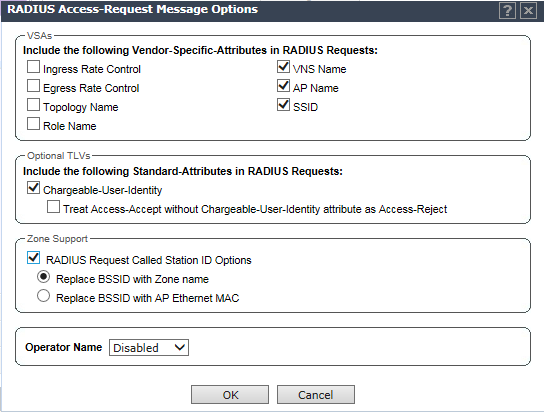To assign RADIUS servers for authentication:

WLAN Services Auth & Acct Tab - Fields and Buttons
| Field/Button | Description |
|---|---|
| Authentication | |
| Mode | Select an authentication
mode from the drop-down list:
|
| Configure | Click to configure the selected mode. For more information, see Configuring Accounting and Authentication. |
| Enable MAC-based authentication | Select to enable the RADIUS server to perform MAC-based authentication for the VNS with Captive Portal. |
| RADIUS Servers | To select a server, see
Selecting RADIUS Servers. The RADIUS servers are defined on the Global Settings screen. For more information, see Defining RADIUS Servers and MAC Address Format. |
| Collect Accounting Information of Wireless Controller | Select this checkbox to enable Controller accounting. |

Note
Both MAC-based Authorization settings work together so that a station can be allowed onto a WLAN Service if it passes MAC-based authentication or Captive Portal authentication. Owners of known stations do not have to enter credentials and owners of unknown stations can get onto the network, if authorized, via Captive Portal.
RADIUS TLVs Dialog - Fields and Buttons
| Field/Button | Description |
|---|---|
| VSAs | |
| Vendor-Specific-Attributes in RADIUS Requests | Select the appropriate
check boxes to include the Vendor Specific Attributes (VSAs)
in the message to the RADIUS server:
For more information, see Defining Common RADIUS Settings. |
| Optional TLVs | |
| Chargeable-User-Identity | Select to NOT return a Chargeable-User-Identity attribute for the RADIUS Server. |
| Treat Access-Accept without Chargeable-User-Identity attribute as Access-Reject | Select to enable feature. |
| Zone Support | |
| RADIUS Request Call Station ID Options: | |
| Replace BSSID with Zone name | Selecting this checkbox to allows the RADIUS client to send the AP Zone name as the BSSID instead of the radio MAC address. This feature can be enabled regardless of whether the Site is using centrally located or local RADIUS servers. Zone name is limited to 32 bytes. Each AP can have its own Zone label although it is often useful to assign the same Zone to multiple APs. |
| Replace BSSID with AP Ethernet MAC | Selecting this checkbox allows the RADIUS client to send the AP Ethernet MAC as the BSSID instead of the radio MAC address. This feature can be enabled regardless of whether the Site is using centrally located or local RADIUS servers. The AP MAC address value is always the AP LAN1 MAC address. |
| Operator Name | Select the name of the user assigned to this RADIUS server from the drop-down list. Once a name is selected, a text box displays to allow text to be entered. |